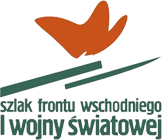The November of 1914 was the month of the greatest Russian successes on the Galician front. The Russian front was then moved into the region of villages of Wolbrom and Słomniki in the vicinity of Kraków, and then east of Brzesko and Nowy Sącz. It ran towards the Carpathian Mountains, where only a few points hindered the tsarist army’s passage to the south. Around November 11, before the commencement of the new Austro-German offensive, the Russian army reached the positions located furthest to the west during the Great War, and occupied almost six seventh of the territory of Galicia and almost the entire Kingdom of Poland, nearly reaching the border with Germany. The Battle of Krzywopłoty was fought November 16-19 in the northern part of Małopolska. Polish legionaries and Austro-Hungarian soldiers managed to stop the Russian advancement to the west.
During the Battle of Kraków, the Russian army reached the point commemorated after the war with the obelisk on Kaim Hill, and the front line ran merely 10 km away from the Main Market Square on December 6, 1914. It was on December 6, 1914, that the crew of the fortress besieged on both sides decided to counterattack and after a several-hour-long intense battle with bayonets, they drove the enemy out from the vicinity of the city.
The Battle of Kraków stopped the main Russian attack and the Austro-Hungarians now planned to definitively stop the advance of the “steam roller” as the Russian offensive was called, and the battles fought south of Kraków December 2-12, 1914, the so-called Battle of Łapanów and Limanowa, were supposed to decide about the result. This decisive battle halted the Russian offensive in Galicia.
The First Brigade of the Polish Legions also fought December 22–25 in the Battle of Łowczówek. This encounter temporarily stopped the Russian forces advancing to the west, which allowed the Austrians to expand the front on the Tarnów – Gorlice line. The front froze at these positions for long months and for the first time in history, it took on the form of developed defensive positions with the lines of rifle pits, shelters, reserve positions, trenches, and so on. The change of the situation occurred only after the Battle of Gorlice fought May 2-5, 1915. It led to the one of the largest breakthroughs of the front in the history of Europe. As a result of the Battle of Gorlice, the Austrian and German forces finally drove the Russian army out to the east and forced it to retreat.
In May of 1915, the Corps of the Austro-Hungarian First Army, operating on the northern bank of the Vistula River, followed the retreating Russian forces. This attack, after the recapture of Przemyśl and Lemberg, almost led to the collapse of the Russian front in the south. During the council of war in Baranowicze, attended by Tsar Nicholas II himself, the decision was made to retain the Kingdom of Poland as long as possible, and to focus on the northwestern front. However, on August 5, in order to avoid the threat of encirclement, the Russians had to desert Warsaw.
Thus, as a result of the spring-summer offensive of the Central Powers, almost the entire Galicia, Kingdom of Poland, Lithuania and Courland fell into the hands of Germans and Austrians.
Mileage front

During the Battle of Kraków, the Russian army reached the point commemorated after the war with the obelisk on Kaim Hill, and the front line ran merely 10 km away from the Main Market Square on December 6, 1914. It was on December 6, 1914, that the crew of the fortress besieged on both sides decided to counterattack and after a several-hour-long intense battle with bayonets, they drove the enemy out from the vicinity of the city.
The Battle of Kraków stopped the main Russian attack and the Austro-Hungarians now planned to definitively stop the advance of the “steam roller” as the Russian offensive was called, and the battles fought south of Kraków December 2-12, 1914, the so-called Battle of Łapanów and Limanowa, were supposed to decide about the result. This decisive battle halted the Russian offensive in Galicia.
The First Brigade of the Polish Legions also fought December 22–25 in the Battle of Łowczówek. This encounter temporarily stopped the Russian forces advancing to the west, which allowed the Austrians to expand the front on the Tarnów – Gorlice line. The front froze at these positions for long months and for the first time in history, it took on the form of developed defensive positions with the lines of rifle pits, shelters, reserve positions, trenches, and so on. The change of the situation occurred only after the Battle of Gorlice fought May 2-5, 1915. It led to the one of the largest breakthroughs of the front in the history of Europe. As a result of the Battle of Gorlice, the Austrian and German forces finally drove the Russian army out to the east and forced it to retreat.
In May of 1915, the Corps of the Austro-Hungarian First Army, operating on the northern bank of the Vistula River, followed the retreating Russian forces. This attack, after the recapture of Przemyśl and Lemberg, almost led to the collapse of the Russian front in the south. During the council of war in Baranowicze, attended by Tsar Nicholas II himself, the decision was made to retain the Kingdom of Poland as long as possible, and to focus on the northwestern front. However, on August 5, in order to avoid the threat of encirclement, the Russians had to desert Warsaw.
Thus, as a result of the spring-summer offensive of the Central Powers, almost the entire Galicia, Kingdom of Poland, Lithuania and Courland fell into the hands of Germans and Austrians.
Mileage front


